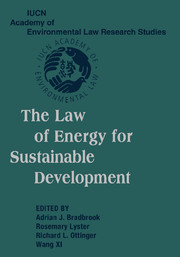Book contents
- Frontmatter
- Contents
- Acknowledgments
- Message from Kofi A. Annan, Secretary-General, United Nations
- Introduction – A Global Learned Society to Address Earth's Evolution: The IUCN Academy of Environmental Law
- Public Lectures on International Environmental Law
- PART ONE SUSTAINABLE DEVELOPMENT AND THE ROLE OF ENERGY LAW
- PART TWO LEGAL ISSUES IN CONTEMPORARY ENERGY LAW
- PART THREE INTERNATIONAL ENERGY LAW
- PART FOUR COMPARATIVE ENERGY LAW
- 18 UNDP: China's Energy Portfolio
- 19 Implementing the Kyoto Protocol beyond the WSSD at Johannesburg – The Japanese Perspective
- 20 Strategy, Policy, and Law Promoting Renewable Energy Resources in China
- 21 Energy Development and Utilization in Africa
- 22 European Energy Law Initiatives
- 23 The Law of Energy for Sustainable Development in Britain
- PART FIVE ELECTRICITY RESTRUCTURING
- PART SIX FINANCING FOR SUSTAINABLE ENERGY
- PART SEVEN CIVIL SOCIETY AND THE PROCEDURAL REQUIREMENTS OF ENERGY LAW FOR SUSTAINABLE DEVELOPMENT
- Index
19 - Implementing the Kyoto Protocol beyond the WSSD at Johannesburg – The Japanese Perspective
Published online by Cambridge University Press: 10 August 2009
- Frontmatter
- Contents
- Acknowledgments
- Message from Kofi A. Annan, Secretary-General, United Nations
- Introduction – A Global Learned Society to Address Earth's Evolution: The IUCN Academy of Environmental Law
- Public Lectures on International Environmental Law
- PART ONE SUSTAINABLE DEVELOPMENT AND THE ROLE OF ENERGY LAW
- PART TWO LEGAL ISSUES IN CONTEMPORARY ENERGY LAW
- PART THREE INTERNATIONAL ENERGY LAW
- PART FOUR COMPARATIVE ENERGY LAW
- 18 UNDP: China's Energy Portfolio
- 19 Implementing the Kyoto Protocol beyond the WSSD at Johannesburg – The Japanese Perspective
- 20 Strategy, Policy, and Law Promoting Renewable Energy Resources in China
- 21 Energy Development and Utilization in Africa
- 22 European Energy Law Initiatives
- 23 The Law of Energy for Sustainable Development in Britain
- PART FIVE ELECTRICITY RESTRUCTURING
- PART SIX FINANCING FOR SUSTAINABLE ENERGY
- PART SEVEN CIVIL SOCIETY AND THE PROCEDURAL REQUIREMENTS OF ENERGY LAW FOR SUSTAINABLE DEVELOPMENT
- Index
Summary
INTRODUCTION
After the adoption of the Marrakesh Accords, global climate change negotiations went into the implementation stage of the Kyoto Protocol. Annex B Parties to the Kyoto Protocol expedited their processes toward achieving the quantified GHGs (Greenhouse Gases) targets inscribed in Annex B so that they could ratify the Protocol by 2002, the tenth anniversary of the adoption of the United Nations Framework Convention on Climate Change (UNFCCC). Japan, as one of the Annex B parties, prepared a domestic policy to combat global warming and ratified the Protocol on June 4, 2002, with a view to contributing to the implementation of the Protocol in time for the World Summit for Sustainable Development (WSSD).
This chapter discusses the essence of the decisions of the Kyoto Protocol, and the development of Japanese domestic policy to achieve the targets set out in the Protocol.
THE KYOTO PROTOCOL
Some of the key elements set out in the Kyoto Protocol are: (1) the quantified GHG reduction targets; (2) introduction of flexible mechanisms; and (3) considerations on land use, land use change, and the forest sector. In this section, each of these will be discussed in some detail.
The quantified reduction targets of GHGs
The Kyoto Protocol set out in its Annex B the differentiated reduction targets of GHG emissions from Annex I parties, with a view to reducing their total emissions in average by five percent relative to the 1990 levels, during the commitment period from year 2008 to 2012.
- Type
- Chapter
- Information
- The Law of Energy for Sustainable Development , pp. 295 - 301Publisher: Cambridge University PressPrint publication year: 2005

